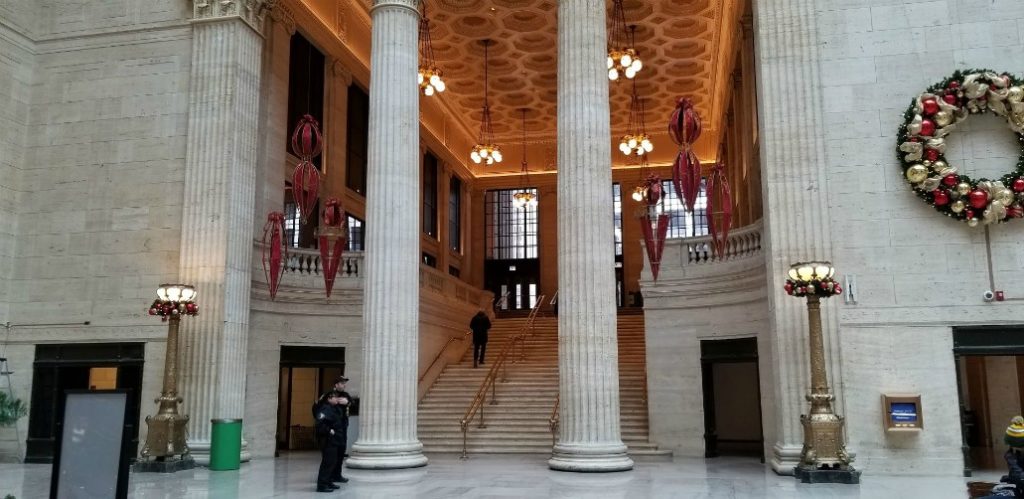By Sabra Goldman, Class of 2010
Union Station is considered to be one of the most historically significant passenger railroad stations
in the nation for its planning and grand architectural design. – Chicago Landmark Commission, May 2002
Chicago’s Union Station opened to great fanfare in 1925. It was one of the last grand train stations built in the country.
In the 1909 Plan of Chicago, Daniel Burnham and Edward Bennett envisioned a union station, one that would unite several railroad lines under one roof. It would be situated west of the loop, across the river. This station would help relieve congestion in the busy loop where the majority of the city’s train stations were located.
The Burnham Company was awarded the commission to design the station. Piers Anderson, the head designer of the company, had studied at the Ecole des Beaux Arts in Paris, at Daniel Burnham’s suggestion. On his return to Chicago, he was hired by Burnham and worked at the firm for the last eight years of Burnham’s life.
The original buildings included a Concourse as well as the Head House with the Great Hall at its center.
The Concourse was razed and replaced with two office towers completed in 1969. What remained of the Concourse was below street level. In 1991, Lucien LaGrange redesigned the Concourse using the Zephyr train as his inspiration. This produced a streamlined, Art Deco-style interior for the Concourse. La Grange was able to open up the Concourse, giving space and light to an otherwise dark, uninviting space.
The Head House is Neo-Classic in design, the exterior reflecting the Greek Revival style; the interior of the Great Hall is Beaux Arts.
Now restoration of the landmarked Union Station Head House has been completed and the Great Hall has been restored to it’s past glory by Burglund Construction. The company is known for its great restorations, including Frank Lloyd Wright’s Unity Temple in Oak Park. They have restored the Great Hall using the specifications of the original plan as a guide. Founded in 1911, the firm operates in a ”state of the art” digital milieu. For example, they presented their proposal to the Amtrak Company as a 3D model .
In order to keep the station operating around the clock, Burglund built a scaffolding over the barrel-domed, glass-tile ceiling called a Quick Deck System. This was done by attaching the scaffolding to the domed ceiling frame. The scaffolding did not touched the floor, leaving it open for pedestrian traffic!
After the 2,052 glass tiles of the barrel-dome were cleaned and restored, a second glass dome was constructed that rose five feet above the original to protect it from the elements.
Other restored features of the Great Hall are the plaster capitals on the travertine columns as well as other plaster work. The beautiful coffered ceilings of the stairways, balconies, and concourse entrance have been restored as well.

This magnificent, meticulous restoration brings alive the grand designs of another age, the likes of which we probably will never see again!





